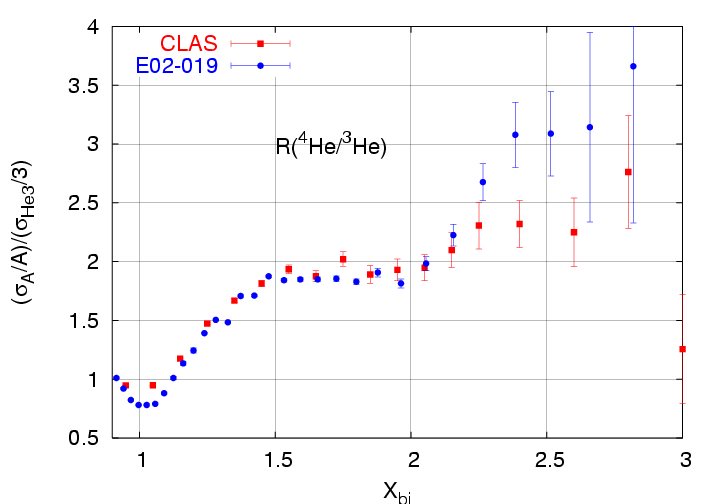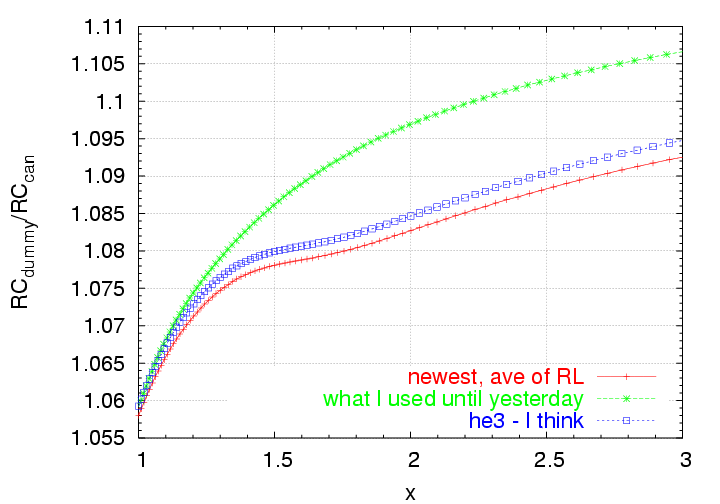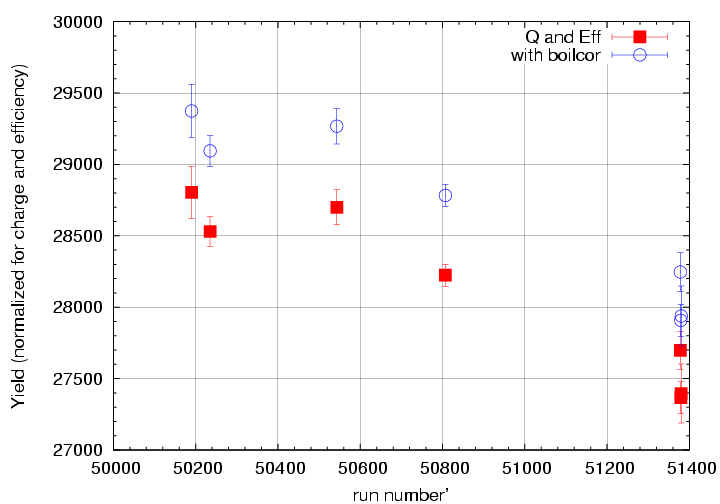This is motivated by the fact that our SRC ratios disagree wildly from those in
Hall B as can be see in this plot:

Note that several things used in the calculation of the cross sections in the above plot were incorrect:
1. The RC tables used were not the most recent version (but, no noticeable difference).
2. The thickness factor (accounting for the differnece between the dummy and cell thicknesses) used was too low (which would mean the dummy was being undersubtracted).
3. The RC_ext factor (to account for differences in the RC for dummy and endcap) wasn't applied correctly - > (yield was being scaled down, also meaning that the dummy was being undersubtracted).
However, fixing (2) and (3) would decrease the He-3 cross section, making the ratio even higher.
To check if the dummy is being subtracted completely/properly, we checked several things. Note: helium-3 and hydrogen shared a target cell, deuterium and helium-4 did not.
1. It should definitely be subtracted *completely* for x>A. Let's check the integrated yields using the following cuts:
Ntuple/Cuts $1 abs(hsdelta)<=9.0
Ntuple/Cuts $2 abs(hsxptar)<=0.07
Ntuple/Cuts $3 hcer_npe>=2
Ntuple/Cuts $4 hsshsum>=0.7
Ntuple/Cuts $5 abs(hsyptar)<=0.03
Ntuple/Cuts $6 abs(x_bj)>3.1
The last cut is 1.2 for hydrogen, 2.1 for deuterium, and 3.1 for
helium-3. Additionaly, the dummy yield had to be corrected for the different RC factor (different between dummy and can). This actually goes with x, but I just used a constant. In doing this, I used 7% for Hydrogen and
deuterium and 8% for helium-3.
The yields (normalized for charge, effs, boiling and in case of dummy
also RC-ext and thickness diff) were:
Hydrogen:
112.8+/-2.3 (H) and 113.6 +/- 1 (Al)
Deuterium:
1272+/-38 (H) and 1192+/-24 (AL)
Helium-3:
27.8 +/- 3.4 (He) and 22.75 +/- 3.4 (Al)
To look at the subtraction in more detail, here's a plot of the helium3, aluminium and net yields (note the file has several pages). The dummy yield has been normalized for target thickness and RC factor difference (as compared to the end caps).There's an unfortunate point at ~2.725, where the helium yield is "low" and the dummy yield is "high" and the difference ends up negative.
Similar plots are available for helium-4 (which sure looks like it goes to zero before x=4) , deuterium , and hydrogen.
Ytar subtraction spectra
Here, we're looking at the ytar spectra of the cryo target, the dummy, and the subtracted cryo yield. If the subtraction is not perfect, then we can maybe do a geometric ytar cut instead and subtract what's left.
A uniform 10% RC_ext correction is applied everywhere. Cuts are same as above, with the exception of #6. Cuts are done on ranges in x instead, indicated on the plots. Each link has several pages. The dummy doesn't have the boiling correction applied, which I should probably fix (since the cryo target *does*).
-- hydrogen
-- deuterium
-- helium-3
RC factor for dummy
Currently, when calculating the RC_dummy/RC_can factor, an average of the radiation lengths for all the cryo targets is used (0.495%). They are:
H: 0.462%
D: 0.533%
He3: 0.425%
He4: 0.559%
To see how much different it would make if the actual RL were used, I ran the x>1 kinematics once, for 18 degrees (cross my fingers) and got the following (note that until this test, I didn't know that I wasn't using the most recent file to begin with):

The difference is minimal and I'm tempted to say won't "fix" the subtraction, if it is even broken to begin with.
Are yields changing?
Using the same cuts as described above, but with x<3, I looked at the dummy yields for the 5.10 GeV setting at 18 degrees. I am hoping there's a mistake here, and I'm checking my work now, but here's what I get, which is unsettling:

Looking at carbon, helium-3/4, it's not really any better. Unfortunately, 40 degree data at 1.14 GeV is stable. Plots can be seen here .


